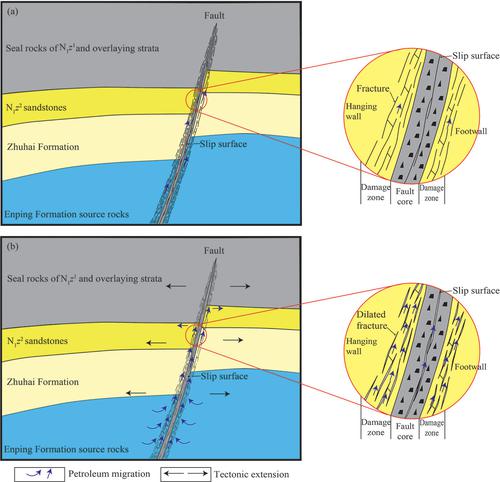当前位置:
X-MOL 学术
›
Acta Geol. Sinica Engl. Ed.
›
论文详情
Our official English website, www.x-mol.net, welcomes your feedback! (Note: you will need to create a separate account there.)
Petroleum Migration Characteristics in the Northeastern Part of the Baiyun Depression, Pearl River Mouth Basin, South China Sea
Acta Geologica Sinica-English Edition ( IF 3.3 ) Pub Date : 2021-01-08 , DOI: 10.1111/1755-6724.14623 Jianhui ZENG 1, 2 , Chen WANG 1, 2, 3 , Gongcheng ZHANG 4 , Yixin YU 1, 2 , Zhongtao ZHANG 5 , Haizhang YNAG 4 , Zhao ZHAO 4 , Rui SUN 4
Acta Geologica Sinica-English Edition ( IF 3.3 ) Pub Date : 2021-01-08 , DOI: 10.1111/1755-6724.14623 Jianhui ZENG 1, 2 , Chen WANG 1, 2, 3 , Gongcheng ZHANG 4 , Yixin YU 1, 2 , Zhongtao ZHANG 5 , Haizhang YNAG 4 , Zhao ZHAO 4 , Rui SUN 4
Affiliation

|
This paper investigates the origin and migration characteristics of petroleum in the northeastern part of the Baiyun Depression, Pearl River Mouth Basin (PRMB). The discovered petroleum in the study area is mainly located in the Lower Zhujiang Member (N1z2) and mainly originated from the Enping Formation source rocks in the eastern sag. Active faults (vertical migration) and N1z2 sandstones (lateral migration) acted as the petroleum migration systems. The fault activities in the Dongsha event controlled the episodic petroleum migration. Fractures in the fault zones provided effective conduits, and overpressure was the driving force. The vertical migration could not cross the fault zones laterally. The petroleum injection areas in the carrier beds were the contact zones of petroleum‐migration faults and carrier beds. The lateral migration was steady‐state migration, and buoyancy was the driving force. The migration pathways in the carrier beds were controlled by the structural morphology. Secondary petroleum migration in the study area could be divided into two parts: vertical migration along the fractures in the fault zones and lateral migration through preferential petroleum migration pathways (PPMPs) in the carrier beds. The petroleum migration behaviors, including migrating direction, driving force, and migration pattern, in the faults and sandstone carrier beds were quite different. This study provides a typical example for comprehending secondary migration processes and has great importance for determining future exploration targets in the deep‐water area of the PRMB.
中文翻译:

南海珠江口盆地白云pression陷东北部油气运移特征
本文研究了珠江口盆地白云De陷东北部石油的成因和运移特征。研究区发现的石油主要位于珠江下游(N 1 z 2),主要来源于东部凹陷的恩平组烃源岩。活动故障(垂直迁移)和N 1 z 2砂岩(侧向运移)充当了石油运移系统。东沙事件的断层活动控制了偶发的石油运移。断裂带中的裂缝提供了有效的管道,而超压是驱动力。垂直迁移不能横向穿过断层带。载体床中的石油注入区域是石油迁移断层与载体床的接触区。横向迁移是稳态迁移,而浮力是驱动力。载体床中的迁移途径受结构形态控制。研究区的次生石油运移可分为两部分:沿断层带裂缝的垂直运移和通过运载体床中优先的石油运移路径(PPMP)的横向运移。断层和砂岩运移床中的石油运移行为,包括运移方向,驱动力和运移方式,是完全不同的。这项研究为理解二次迁移过程提供了一个典型实例,对于确定PRMB深水区的未来勘探目标具有重要意义。
更新日期:2021-02-22
中文翻译:

南海珠江口盆地白云pression陷东北部油气运移特征
本文研究了珠江口盆地白云De陷东北部石油的成因和运移特征。研究区发现的石油主要位于珠江下游(N 1 z 2),主要来源于东部凹陷的恩平组烃源岩。活动故障(垂直迁移)和N 1 z 2砂岩(侧向运移)充当了石油运移系统。东沙事件的断层活动控制了偶发的石油运移。断裂带中的裂缝提供了有效的管道,而超压是驱动力。垂直迁移不能横向穿过断层带。载体床中的石油注入区域是石油迁移断层与载体床的接触区。横向迁移是稳态迁移,而浮力是驱动力。载体床中的迁移途径受结构形态控制。研究区的次生石油运移可分为两部分:沿断层带裂缝的垂直运移和通过运载体床中优先的石油运移路径(PPMP)的横向运移。断层和砂岩运移床中的石油运移行为,包括运移方向,驱动力和运移方式,是完全不同的。这项研究为理解二次迁移过程提供了一个典型实例,对于确定PRMB深水区的未来勘探目标具有重要意义。



























 京公网安备 11010802027423号
京公网安备 11010802027423号